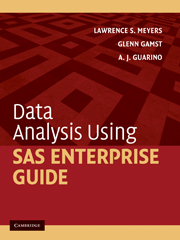Book contents
- Frontmatter
- Contents
- Preface
- Acknowledgments
- I Introducing SAS Enterprise Guide
- II Performing Analyses and Viewing Output
- III Manipulating Data
- IV Describing Data
- V Score Distribution Assumptions
- VI Correlation and Prediction
- VII Comparing Means: The t Test
- VIII Comparing Means: ANOVA
- IX Nonparametric Procedures
- X Advanced ANOVA Techniques
- XI Analysis of Structure
- 32 Factor Analysis
- 33 Canonical Correlation Analysis
- References
- Author Index
- Subject Index
33 - Canonical Correlation Analysis
Published online by Cambridge University Press: 05 June 2012
- Frontmatter
- Contents
- Preface
- Acknowledgments
- I Introducing SAS Enterprise Guide
- II Performing Analyses and Viewing Output
- III Manipulating Data
- IV Describing Data
- V Score Distribution Assumptions
- VI Correlation and Prediction
- VII Comparing Means: The t Test
- VIII Comparing Means: ANOVA
- IX Nonparametric Procedures
- X Advanced ANOVA Techniques
- XI Analysis of Structure
- 32 Factor Analysis
- 33 Canonical Correlation Analysis
- References
- Author Index
- Subject Index
Summary
Overview
Canonical correlation analysis is a member of the general linear model family. Introduced by Hotelling (1936a), it is a complex multivariate procedure that tends to be used less frequently than MANOVA and factor analysis. Its purpose is to predict a combination of one set of variables based on a combination of another set of variables. Working with canonical correlation involves conceptually combining elements from both linear regression and factor analysis. Relatively extensive treatments of canonical correlation analysis can be found in Lattin et al. (1993), Stevens (2002), and Thompson (1984).
Although we discuss the details of the procedure, it is worthwhile to note that in recent years researchers have been using canonical correlation analysis less frequently than in the past. One reason for this shift is because the solution optimizes the degree of statistical prediction accomplished by the canonical functions without the benefit of theory within which the relationships can be meaningfully interpreted (e.g., Guarino, 2004; Nunnally, 1978). Such a lack of theoretical framework can sometimes lead to “multivariate fishing expeditions” (Nunnally & Bernstein, 1994). Canonical correlation analysis is becoming increasingly supplanted by the use of structural equation modeling (e.g., Fan, 1997). Such an approach specifies a model that is then able to be tested by determining the degree to which it fits the data. Structural equation modeling is beyond the scope of this book, but readers may consult Byrne (2001), Loehlin (2004), Maruyama (1998), and Meyers et al. (2006) for more complete treatments of the topic.
- Type
- Chapter
- Information
- Data Analysis Using SAS Enterprise Guide , pp. 345 - 364Publisher: Cambridge University PressPrint publication year: 2009



